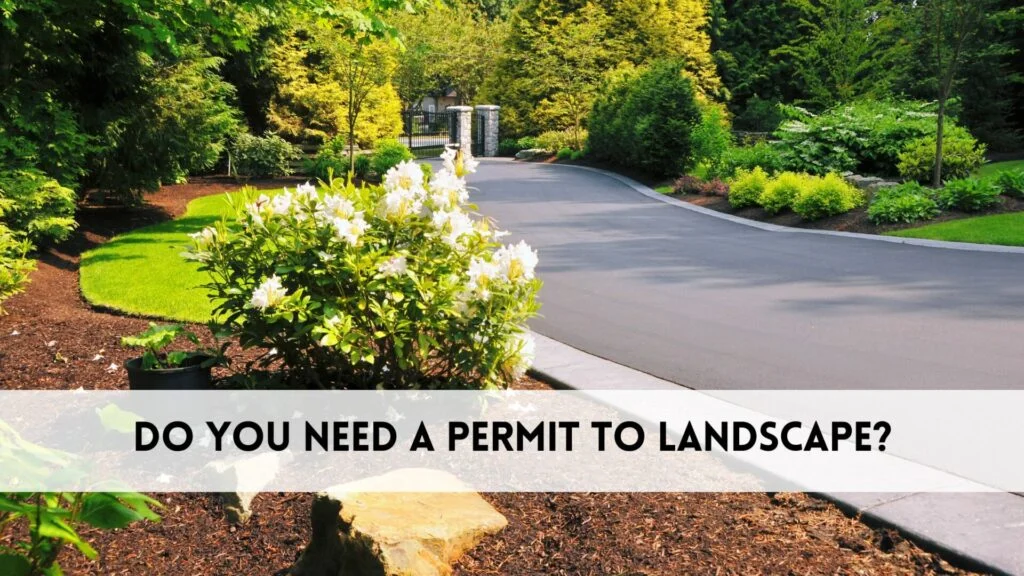Landscaping can be a great way to enhance the beauty and value of your property, creating an inviting and functional outdoor space. However, before embarking on any landscaping project, it’s essential to determine whether you need a permit. Do you need a permit to landscape? This is a common question among homeowners and property developers, as regulations vary depending on the scope and scale of the project.
While minor tasks such as planting flowers or small shrubs may not require official approval, larger landscaping projects such as building fences, retaining walls, or making significant changes to the land often do. Understanding the need for a landscaping permit is crucial to avoid costly fines or delays. Failing to obtain the necessary permits can result in the removal of the work, additional expenses, or legal complications. In this article, we’ll walk you through the types of landscaping projects that require permits, the application process, and the potential consequences of skipping this step.
Do you need a permit to landscape?
The question of whether you need a permit for landscaping can be complex. In general, landscaping permits are required for projects that have a significant impact on the landscape, structure, or functionality of your property. Different areas have varying regulations, so it’s essential to check with local authorities to determine if your landscaping project requires approval. Here are some types of permits:
Building Permit
A building permit is typically required for structural landscaping projects. This includes tasks like constructing retaining walls, large fences, or pergolas, which can alter the land’s structure or affect neighboring properties. Retaining walls, for instance, may need a building permit if they exceed a certain height or impact drainage systems.
Large fences, especially those that exceed height limits or are located near property lines, may also require approval. Obtaining a building permit ensures that these structures are safe, compliant with local zoning codes, and won’t negatively affect surrounding properties. Additionally, building permits are necessary to maintain the integrity of your property and ensure that the project adheres to proper safety standards and regulations.
Excavation Permit
An excavation permit is essential for projects involving digging, grading, or significantly altering the landscape’s elevation. These activities can affect water drainage, soil stability, and the overall structure of your property. Excavation can also impact neighboring properties, so obtaining this permit ensures that the project is carried out according to local laws and environmental standards.
Grading in landscaping or excavation can change the flow of water on the property, which may lead to erosion or flooding. With an excavation permit, local authorities ensure that the work will not disrupt the natural landscape and that proper safeguards are in place to protect both your property and the surrounding area.
Tree Removal Permit
A tree removal permit is required when removing trees, particularly mature or protected ones. Many areas have strict regulations regarding the removal of trees due to environmental concerns or local conservation laws. Trees help with air quality, water retention, and provide habitat for wildlife, making their removal highly regulated.
In some regions, any tree of a certain size or species may require a permit for removal. Even if the tree is on your property, it’s important to check with local authorities to ensure that the removal complies with local environmental laws and conservation efforts. Failing to obtain a tree removal permit can result in hefty fines and the requirement to replant the tree.
Zoning Permit
A zoning permit is required when a landscaping project alters the designated use of the land. For example, converting part of your yard into a paved parking area or adding an outdoor living space may require a zoning permit to ensure compliance with local zoning laws.
These laws govern how land can be used in different areas, with specific rules for residential, commercial, or industrial zoning. A zoning permit ensures that your landscaping project aligns with your area’s land use regulations. It also helps prevent disputes with neighbors and ensures that your project meets local standards for safety, aesthetics, and functionality.
Floodplain or Environmental Permit
If your landscaping project involves working in or near a floodplain or environmentally sensitive area, a floodplain or environmental permit is required. These areas are typically regulated to protect water sources, wildlife habitats, and prevent damage from flooding. Landscaping activities in these regions, such as altering water flow, planting near riverbanks, or disturbing native vegetation, can negatively impact the ecosystem or increase flood risks.
A floodplain or environmental permit ensures that your landscaping project will not contribute to environmental degradation. It helps local authorities assess the potential impacts of your project on the surrounding ecosystem and ensures compliance with environmental protection laws and sustainable practices.
Landscaping Projects That May Need Permits
Some landscaping projects may require permits based on local regulations. Here are some common landscaping projects that often need approval:
| Landscaping Project | Permit Needed? | Details |
| Retaining Walls | Yes | Typically needed for walls over a certain height, often affecting drainage. |
| Fences | Sometimes | A permit may be required depending on the height and location of the fence. |
| Major Excavation/Grading | Yes | Any project that alters the landscape’s elevation or drainage may require a permit. |
| Tree Removal | Yes | Required for large trees or those in protected areas. |
| Paving and Hardscaping | Yes | Often needed for significant changes like patios, driveways, and walkways. |
| Outdoor Structures | Yes | Includes structures such as sheds, decks, or pergolas. |
Retaining Walls
Retaining walls often require a permit, especially if they exceed a certain height limit. These walls are used to stabilize sloped land and prevent soil erosion. If a retaining wall is too tall or improperly constructed, it can interfere with drainage patterns and cause water runoff problems. In many areas, a permit is required to ensure the wall is built to local safety standards and does not negatively impact neighboring properties or natural drainage systems. Permits also ensure that the wall will not block or disrupt water flow, which could lead to flooding or soil erosion. Always check with your local zoning office to determine the height restrictions and necessary permits for constructing a retaining wall on your property.
Fences
A fence permit may be required depending on the height, location, and purpose of the fence. In some areas, fences above a certain height—typically around 6 feet—require approval to ensure they meet safety and aesthetic standards. Fences that are placed near property lines or in front yards often have stricter requirements to avoid obstructing visibility for traffic or pedestrians. Additionally, certain zoning regulations might restrict the type of material or design allowed. Before constructing a fence, it is essential to verify the height and placement restrictions with your local zoning office. Obtaining a fence permit ensures your fence complies with local building codes and prevents potential legal disputes with neighbors.
Major Excavation/Grading
Major excavation or grading involves altering the landscape’s elevation, typically by digging, filling, or leveling the ground. This type of work can significantly affect drainage patterns, soil stability, and the overall environment of the property. Changes in the landscape’s slope can lead to water runoff, erosion, or flooding, potentially damaging both your property and your neighbor’s. To prevent these issues, local authorities require permits for large-scale excavation or grading projects. A permit ensures that the project will be completed according to safety standards and environmental guidelines. It also helps to protect the surrounding infrastructure and prevent any unintended consequences that may arise from altering the landscape’s natural flow.
Tree Removal
A tree removal permit is necessary when removing large trees, particularly those that are mature, protected, or located in environmentally sensitive areas. Many regions have strict regulations to preserve local flora, especially for trees that provide crucial environmental benefits such as improving air quality, providing wildlife habitats, and preventing soil erosion. Permits ensure that the removal is done in compliance with local conservation laws and that alternatives like pruning or relocation are considered before removing the tree entirely. In some areas, there are specific restrictions on removing trees near waterfronts or in designated conservation zones. Always check with local authorities to ensure you comply with tree preservation laws before removing any tree on your property.
Paving and Hardscaping
Paving and hardscaping projects often require a permit, especially when they involve significant changes to your yard, such as adding a driveway, patio, or walkway. These projects typically alter the land’s surface and can affect water drainage, the flow of stormwater, or even property boundaries. For example, the installation of a new driveway or large patio could obstruct natural water flow, potentially leading to flooding or erosion. A permit ensures that the work adheres to local zoning codes, safety standards, and environmental regulations. Additionally, the materials used for hardscaping (e.g., concrete, stone, asphalt) may be regulated to maintain uniformity and aesthetics in the neighborhood. Always consult with your local authorities before starting any hardscaping project to determine if a permit is needed.
Outdoor Structures
Outdoor structures, such as sheds, decks, and pergolas, typically require a permit because they involve building or significant alteration to your property. These structures are often considered permanent additions to your property, and their construction can affect your land’s functionality and appearance. A permit ensures that the structure complies with local building codes, zoning laws, and safety standards. For example, decks and pergolas must be safely anchored, and sheds must adhere to size restrictions and setback requirements from property lines. Permits also help ensure that outdoor structures do not interfere with utilities, drainage systems, or neighboring properties. Always check with your local zoning office to confirm the required permits before starting construction on any outdoor structure.
What Happens if You Don’t Get a Permit?
Failing to secure the necessary permits for your landscaping project can lead to significant complications. Ignoring landscaping regulations and bypassing the required approvals may result in the following consequences:
Fines:
Local authorities can impose fines for unauthorized landscaping work. These fines can vary depending on the scope of the project and the regulations in your area. Not obtaining a landscaping permit could lead to costly penalties, making the project far more expensive than initially planned.
Work Reversal:
If the landscaping project is discovered to be done without a permit, you may be required to undo the work and restore the property to its original condition. This can include demolishing retaining walls, removing structures, or even replanting trees. The cost of reversing the work could be substantial, and this could set your project back significantly.
Delays in Future Renovations or Property Sale:
The absence of proper permits can complicate plans, whether you’re looking to sell your property or embark on additional renovations. Potential buyers may demand verification that all landscaping work is compliant with local codes. Furthermore, if you are planning more significant improvements, the lack of permits may cause delays, or you may need to tear down unapproved structures to meet code requirements.
Legal Issues:
In certain cases, unauthorized landscaping projects can lead to legal disputes. This is especially true if the work impacts neighboring properties, violates zoning laws, or creates environmental hazards. Legal action could include lawsuits from neighbors or municipal authorities, and failure to resolve these issues could result in costly legal fees and court orders to reverse the work.
How to Apply for a Permit?
The process for applying for a landscaping permit varies by location and the type of project. Typically, the steps include:
- Determine Permit Requirements: Check with your local building or zoning department to confirm if a permit is required.
- Prepare Necessary Documents: You may need to submit a site plan, project description, or design layout of your landscaping work.
- Submit Your Application: Complete the permit application and submit it with any required documents.
- Pay Fees: Some areas require a fee to process the permit application. The amount varies by jurisdiction.
- Wait for Approval: Once submitted, your application will be reviewed, and you may be required to make adjustments to your plans based on feedback.
- Begin the Project: After receiving approval, you can move forward with your landscaping project.
Always keep a copy of the approved permit on-site during the project, as you may need to show it to inspectors.
The Landscaping Permit Process
The landscaping permit process can be relatively simple if you follow these key steps:
Research Local Regulations
Before starting your landscaping project, it’s essential to check with your local building or zoning department to determine if a permit is required. Landscaping permit requirements can vary greatly depending on your location, as different municipalities have different rules and codes. Some areas may require permits for projects that significantly alter the landscape, such as excavation or installing structures, while others may not. Researching local regulations ensures you comply with all relevant landscaping laws. You can often find information online or contact your local authorities directly to get specific requirements for your area. By doing so, you can avoid unnecessary delays and potential fines, ensuring your project remains legal and compliant.
Prepare Documentation
Once you’ve confirmed whether a landscaping permit is required, the next step is to gather and prepare all necessary documentation for your application. This typically includes detailed project plans or blueprints that show how your landscaping project will impact the land. Landscaping permit requirements often ask for details like changes in grading, drainage systems, or the installation of structures such as retaining walls or fences. Including precise measurements, material specifications, and an outline of how the landscaping will look once completed is crucial. A well-prepared application ensures that your project is reviewed thoroughly and reduces the likelihood of delays. Ensure you also have the correct forms filled out as per the local guidelines.
Submit the Application
After gathering your required documentation, the next step is to submit your permit application to the relevant local authority. Make sure to carefully follow the landscaping permit process and adhere to any submission instructions. Applications can often be submitted either in person, online, or by mail, depending on your municipality’s guidelines. Ensure you include all necessary documents and pay any applicable fees at the time of submission. Omitting documents or failing to follow submission procedures can lead to delays or a rejected application. Keeping copies of all submitted materials is essential, so you have a record of your application in case of any issues later.
Receive Approval or Denial
After submitting your landscaping permit application, the local authorities will review your documents and plans to ensure they meet the area’s landscaping regulations. The approval process may take anywhere from a few days to several weeks, depending on the complexity of your project and the local authority’s workload. You’ll receive a notification regarding your application’s status either approval, denial, or a request for more information. If your application is approved, you can proceed with your project. If denied, local authorities will typically provide feedback on why the application was rejected and suggest changes you need to make before resubmitting. Addressing these concerns promptly will increase the chances of approval on the second attempt.
Begin the Project
Once you’ve received approval for your landscaping project, you can begin the work. Ensure that you follow the specific conditions and guidelines outlined in your permit to avoid future complications. Local authorities often conduct site inspections to ensure compliance with approved plans. Keeping the permit on-site and visible during the project is a good practice in case inspectors stop by. It’s also important to monitor the work to make sure it aligns with the original plans submitted to the authorities. By adhering to the landscaping permit requirements, you can ensure that your project is completed without legal issues, and you can enjoy your new outdoor space with peace of mind.
Final Words
Understanding whether you need a permit for landscaping is essential for any homeowner or contractor planning a project. Securing the proper landscaping permits ensures that your work complies with local laws, safety standards, and zoning regulations. Whether you’re installing a fence, removing a tree, or building a retaining wall, failure to obtain a permit can result in fines, removal of the work, or even legal action.
Always verify with local authorities to determine which projects require a permit in your area. It’s also important to follow the landscaping permit process thoroughly, which includes submitting the correct paperwork, paying fees, and waiting for approval before starting work. By understanding the requirements and adhering to them, you can avoid unnecessary complications and enjoy your landscaping improvements without any legal or financial issues. This proactive approach will help ensure that your project is completed smoothly and without delay.



